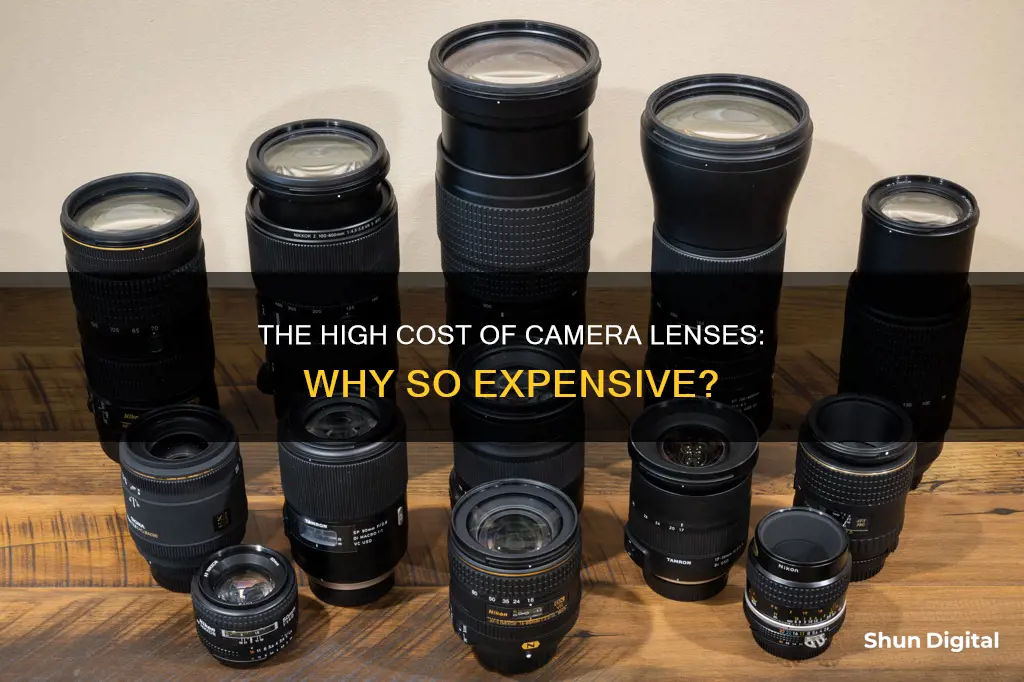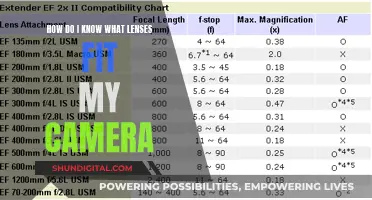
Camera lenses are expensive due to a combination of factors, including production costs, brand value, and the complexity of design. The manufacturing process involves intricate steps, from shaping high-quality glass elements to coating and assembling them with precision. Lenses also undergo rigorous testing to ensure optimal performance and durability. Additionally, the research and development required to create advanced features, such as image stabilization and autofocus, contribute to the overall expense. Brand names and their marketing strategies further influence the pricing of camera lenses.
| Characteristics | Values |
|---|---|
| Complexity of Design | Sophisticated design, lightweight, small, weather sealing |
| Research & Development | Time-consuming and labor-intensive, new materials, new trends, technology |
| High-Quality Raw Materials | High-quality glass, calibrated to exact standards, fast, quiet, reliable motors |
| Precision Manufacturing | Requires skilled workers, manual labor, sterile environment, quality control |
| Brand Name | |
| Production Cost | High production standards, testing, inspections, hand-assembled, high-quality components |
| New Features | Image stabilization, non-rotating front element, internal zoom, silent autofocus, full-time manual focus |
| Manufacturing & Design | High-end manufacturing processes, coating processes, barrel production, meeting requirements |
| Marketing | |
| Image Quality | Complex optical design, sharp and clear images, optimized results, superb colours |
| Durability | Quality internal and external materials, rust-resistant, long-lasting |
| Lens Format | Portrait and landscape lens, telephoto lens, wide-angle lens |
What You'll Learn

Complexity of design
Camera lenses are expensive due to the complexity of their design. While they may seem like simple devices, the design of each lens is highly sophisticated. This is because lenses perform a complex job: they focus and manipulate light as it passes through the camera and onto the sensor. They accomplish this by bending and filtering light using numerous elements within the lens body. The shape, thickness, clarity, curvature, and position of these elements must be calculated very precisely.
The design process is further complicated by the need for the lens to be lightweight and small enough to be usable when mounted on a camera. Additionally, weather sealing is an important aspect of lens design, as the seals and coatings on new lenses allow them to be used outside of a studio by preventing water, dirt, and dust from getting inside the lens body.
The manufacturing process of camera lenses also contributes to their high cost. The glass elements used in lenses must be handled and shaped by experienced engineers, and the lenses are typically hand-assembled. The internal components of camera lenses are made from high-quality materials such as brass or metal, which add to the overall price. The production process involves multiple testing and inspection steps to ensure the lenses are easy to use and meet high production standards.
In addition to the complexity of design, the brand name, raw materials used, and the amount of human involvement in the manufacturing and testing process also impact the cost of camera lenses.

Research and development
Camera lenses are expensive due to the high costs of research and development (R&D). Companies invest heavily in R&D to maintain their competitive edge and market position. This includes studying new trends in photography, understanding the target market, and selecting the best materials for their products.
The R&D process can be lengthy, often taking years, and involves extensive polling and market research. This labour-intensive process adds significantly to the final cost of the lens. Companies must also recover these R&D costs when the lens is launched, which further increases the price.
Another factor contributing to the high cost of camera lenses is the need to stay ahead in a highly competitive market. Companies must continuously innovate and incorporate new technologies and materials into their lenses to keep their customers from switching to competitors. This constant drive to improve and stay ahead adds to the overall expense of developing and manufacturing lenses.
The complexity of lens design also plays a role in the high cost of R&D. A camera lens must focus and manipulate light as it passes through the camera, requiring precise calculations for the shape, thickness, clarity, curvature, and position of the lens elements. Additionally, the lens must be lightweight and compact while still delivering the desired optical performance. This intricate design process demands significant investment in research and development.

High-quality raw materials
Camera lenses are expensive because of the high-quality raw materials used in their production. The quality of the raw materials used in manufacturing lenses determines their durability and performance.
The glass used in the lens elements must be of extremely high quality and calibrated to very exact standards. The high level of refinement required for this glass adds to the cost of the lens. The glass must be able to bend and filter light using multiple elements within the lens body. The shape, thickness, clarity, curvature, and position of these elements must be calculated very precisely.
The motors that drive the focusing mechanism are another component that must be of excellent quality. The motor needs to be fast, quiet, reliable, small, and lightweight. This significantly adds to the overall price and manufacturing costs.
The external and internal durability of the lens is also dependent on the quality of the raw materials used. The lens barrel, which supports other various elements, is made of metal or composite materials. The metal mounts, grooves, and moving portions of the lens are machined to produce the external body.
The quality of the raw materials used in the manufacturing process is a primary reason why consumer-grade lenses are cheaper than professional-grade lenses. Consumer-grade lenses are mostly made of plastic, which is cheaper than metal. They are also assembled by automated machines, whereas professional lenses are hand-crafted by experienced engineers.

Precision manufacturing
Camera lenses are expensive due to the precision manufacturing required to produce them. The process involves highly skilled workers and specialised machinery to assemble the many intricate components.
Firstly, the glass elements of the lens must be shaped by a curve generator machine into concave and convex forms. Then, they undergo a grinding and polishing process. All of this is done on an industrial scale, requiring a lot of energy.
The formed lenses are then coated with metal or composite material to prevent reflections and protect the glass from oxidation. The coating materials are also high-end and expensive.
The barrel of the lens, which supports the other elements, is made from metal mounts, grooves, and a moving portion of the lens. These are machined to produce the external body of the lens.
The lens must also be weather-sealed to prevent water, dust, and dirt from getting inside. This adds to the manufacturing complexity and cost.
In addition, camera lenses are hand-assembled, which requires a lot of manual labour and skilled workers. This increases the cost compared to automated assembly processes.
The precision manufacturing of camera lenses also requires a sterile environment to prevent dust, dirt, and moisture from getting into the lens during assembly. This further adds to the cost of production.
Finally, each lens must undergo rigorous quality control inspections and testing to ensure they meet the high standards required for photography. This includes testing for optical resolution, mechanical function, and autofocus response.

Brand name
The brand name of a camera lens can have a significant impact on its price. When it comes to camera equipment, the reputation and recognition of certain brands can lead to higher prices. This is often due to a combination of factors, including marketing, perceived quality, and exclusivity.
Marketing and Brand Awareness
Well-known brands in the photography industry tend to invest heavily in marketing and advertising campaigns to promote their products. These campaigns can be costly and include television, print, and digital advertisements. The goal is to reach a wide audience and establish their lenses as the best or most innovative on the market. This type of brand awareness can influence consumers' perceptions and contribute to the higher prices associated with certain brands.
Perceived Quality and Exclusivity
Established brands in the camera lens market often have a reputation for high-quality products. This perception of quality can lead to higher prices as consumers are willing to pay a premium for what they believe is a superior product. Additionally, some brands may offer exclusive or limited-edition lenses, creating a sense of exclusivity that can drive up prices.
Research and Development
Brands that are known for their innovative features and cutting-edge technology invest significant resources into research and development (R&D). They employ skilled engineers and designers to continuously improve their lenses, ensuring they stay ahead of the competition. This constant pursuit of technological advancement and the desire to offer the latest and greatest features can contribute to higher prices for branded lenses.
Customer Loyalty and Prestige
Strong brand names often cultivate customer loyalty. Photographers who have had positive experiences with a particular brand may be willing to pay a higher price for new lenses from the same brand, trusting that the quality and performance will meet their expectations. Additionally, the prestige associated with certain brands can also influence pricing. Some photographers may be willing to pay a premium for lenses from prestigious brands, even if comparable options are available at lower prices.
Brand Comparison and Alternatives
It is important to note that brand name influence on pricing is not always solely responsible for the high cost of camera lenses. Other factors, such as raw material costs, manufacturing processes, and the incorporation of advanced technologies, also play a significant role. Additionally, it is worth considering that comparable third-party lenses may offer similar or even better performance at a lower price. When making a purchasing decision, it is essential to research and compare different brands and models to find the best value for your needs.
Frequently asked questions
Camera lenses are expensive due to the complexity of their design, the high-quality raw materials used, the precision manufacturing process, and the extensive research and development that goes into creating them.
Camera lenses can range in price from $100 to $5000, with high-quality lenses typically starting at around $1000.
The type of lens, the quality of raw materials, the manufacturing process, and the brand name all contribute to the cost of camera lenses.
Expensive camera lenses can be worth the investment, especially for professional photographers, as they offer superior optical performance, advanced features, and higher durability. However, it is possible to find comparable or even better alternatives at a lower price by researching and comparing different brands and models.







